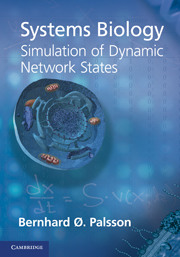Book contents
- Frontmatter
- Contents
- Preface
- 1 Introduction
- 2 Basic concepts
- PART I SIMULATION OF DYNAMIC STATES
- PART II BIOLOGICAL CHARACTERISTICS
- 7 Orders of magnitude
- 8 Stoichiometric structure
- 9 Regulation as elementary phenomena
- PART III METABOLISM
- PART IV MACROMOLECULES
- APPENDIX A Nomenclature
- APPENDIX B Homework problems
- References
- Index
7 - Orders of magnitude
from PART II - BIOLOGICAL CHARACTERISTICS
Published online by Cambridge University Press: 05 August 2012
- Frontmatter
- Contents
- Preface
- 1 Introduction
- 2 Basic concepts
- PART I SIMULATION OF DYNAMIC STATES
- PART II BIOLOGICAL CHARACTERISTICS
- 7 Orders of magnitude
- 8 Stoichiometric structure
- 9 Regulation as elementary phenomena
- PART III METABOLISM
- PART IV MACROMOLECULES
- APPENDIX A Nomenclature
- APPENDIX B Homework problems
- References
- Index
Summary
The simulation examples in the previous chapters are conceptual. As we begin to build simulation models of realistic biological processes, we need to obtain information such as the numerical values of the parameters that appear in the dynamic mass balances. We thus go through a process of estimating the approximate numerical values of various quantities and parameters. Size, mass, chemical composition, metabolic complexity, and genetic makeup represent characteristics for which we now have extensive data available. Based on typical values for these quantities, we show how one can make useful estimates of concentrations and the dynamic features of the intracellular environment.
Cellular composition and ultra-structure
It is often stated that all biologists have two favorite organisms, Escherichia coli and another one. Fortunately, much data exists for E. coli, and we can go through parameter and variable estimation procedures using it as an example. These estimation procedures can be performed for other target organisms, cell types, and cellular processes in an analogous manner if the appropriate data are available. We organize the discussion around key questions.
The interior of a cell The typical bacterial cell, like E. coli, is on the order of micrometers in size (Figure 7.1a). The E. coli cell is a short cylinder, about 2–4 μm in length with a 0.5 to 1.5 μm diameter; Figure 7.1b. The size of the E. coli cell is growth-rate dependent; the faster the cell grows, the larger it is.
Information
- Type
- Chapter
- Information
- Systems Biology: Simulation of Dynamic Network States , pp. 111 - 131Publisher: Cambridge University PressPrint publication year: 2011
